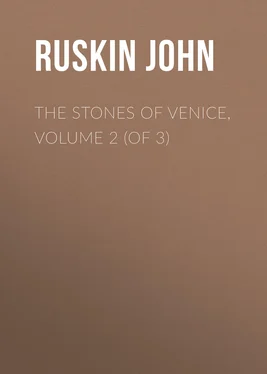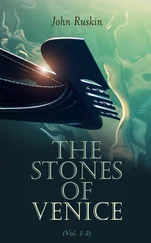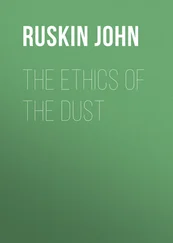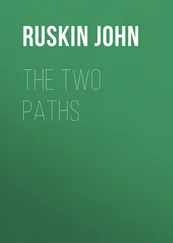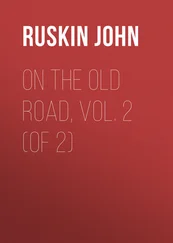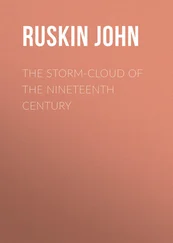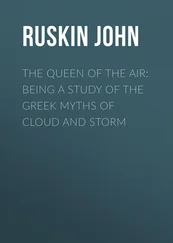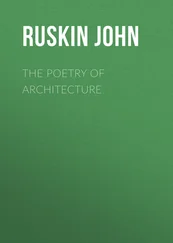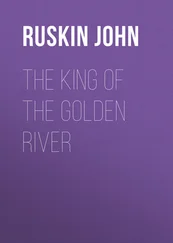John Ruskin - The Stones of Venice, Volume 2 (of 3)
Здесь есть возможность читать онлайн «John Ruskin - The Stones of Venice, Volume 2 (of 3)» — ознакомительный отрывок электронной книги совершенно бесплатно, а после прочтения отрывка купить полную версию. В некоторых случаях можно слушать аудио, скачать через торрент в формате fb2 и присутствует краткое содержание. Жанр: foreign_antique, foreign_home, architecture_book, literature_19, visual_arts, на английском языке. Описание произведения, (предисловие) а так же отзывы посетителей доступны на портале библиотеки ЛибКат.
- Название:The Stones of Venice, Volume 2 (of 3)
- Автор:
- Жанр:
- Год:неизвестен
- ISBN:нет данных
- Рейтинг книги:5 / 5. Голосов: 1
-
Избранное:Добавить в избранное
- Отзывы:
-
Ваша оценка:
- 100
- 1
- 2
- 3
- 4
- 5
The Stones of Venice, Volume 2 (of 3): краткое содержание, описание и аннотация
Предлагаем к чтению аннотацию, описание, краткое содержание или предисловие (зависит от того, что написал сам автор книги «The Stones of Venice, Volume 2 (of 3)»). Если вы не нашли необходимую информацию о книге — напишите в комментариях, мы постараемся отыскать её.
The Stones of Venice, Volume 2 (of 3) — читать онлайн ознакомительный отрывок
Ниже представлен текст книги, разбитый по страницам. Система сохранения места последней прочитанной страницы, позволяет с удобством читать онлайн бесплатно книгу «The Stones of Venice, Volume 2 (of 3)», без необходимости каждый раз заново искать на чём Вы остановились. Поставьте закладку, и сможете в любой момент перейти на страницу, на которой закончили чтение.
Интервал:
Закладка:
§ VIII. Of the main facts of this tale there is no doubt. They were embellished afterwards, as usual, by many fanciful traditions; as, for instance, that, when the sarcophagus was discovered, St. Mark extended his hand out of it, with a gold ring on one of the fingers, which he permitted a noble of the Dolfin family to remove; and a quaint and delightful story was further invented of this ring, which I shall not repeat here, as it is now as well known as any tale of the Arabian Nights. But the fast and the discovery of the coffin, by whatever means effected, are facts; and they are recorded in one of the best-preserved mosaics of the north transept, executed very certainly not long after the event had taken place, closely resembling in its treatment that of the Bayeux tapestry, and showing, in a conventional manner, the interior of the church, as it then was, filled by the people, first in prayer, then in thanksgiving, the pillar standing open before them, and the Doge, in the midst of them, distinguished by his crimson bonnet embroidered with gold, but more unmistakably by the inscription “Dux” over his head, as uniformly is the case in the Bayeux tapestry, and most other pictorial works of the period. The church is, of course, rudely represented, and the two upper stories of it reduced to a small scale in order to form a background to the figures; one of those bold pieces of picture history which we in our pride of perspective, and a thousand things besides, never dare attempt. We should have put in a column or two of the real or perspective size, and subdued it into a vague background: the old workman crushed the church together that he might get it all in, up to the cupolas; and has, therefore, left us some useful notes of its ancient form, though any one who is familiar with the method of drawing employed at the period will not push the evidence too far. The two pulpits are there, however, as they are at this day, and the fringe of mosaic flower-work which then encompassed the whole church, but which modern restorers have destroyed, all but one fragment still left in the south aisle. There is no attempt to represent the other mosaics on the roof, the scale being too small to admit of their being represented with any success; but some at least of those mosaics had been executed at that period, and their absence in the representation of the entire church is especially to be observed, in order to show that we must not trust to any negative evidence in such works. M. Lazari has rashly concluded that the central archivolt of St. Mark’s must be posterior to the year 1205, because it does not appear in the representation of the exterior of the church over the northern door; 27but he justly observes that this mosaic (which is the other piece of evidence we possess respecting the ancient form of the building) cannot itself be earlier than 1205, since it represents the bronze horses which were brought from Constantinople in that year. And this one fact renders it very difficult to speak with confidence respecting the date of any part of the exterior of St. Mark’s; for we have above seen that it was consecrated in the eleventh century, and yet here is one of its most important exterior decorations assuredly retouched, if not entirely added, in the thirteenth, although its style would have led us to suppose it had been an original part of the fabric. However, for all our purposes, it will be enough for the reader to remember that the earliest parts of the building belong to the eleventh, twelfth, and first part of the thirteenth century; the Gothic portions to the fourteenth; some of the altars and embellishments to the fifteenth and sixteenth; and the modern portion of the mosaics to the seventeenth.
§ IX. This, however, I only wish him to recollect in order that I may speak generally of the Byzantine architecture of St. Mark’s, without leading him to suppose the whole church to have been built and decorated by Greek artists. Its later portions, with the single exception of the seventeenth century mosaics, have been so dexterously accommodated to the original fabric that the general effect is still that of a Byzantine building; and I shall not, except when it is absolutely necessary, direct attention to the discordant points, or weary the reader with anatomical criticism. Whatever in St. Mark’s arrests the eye, or affects the feelings, is either Byzantine, or has been modified by Byzantine influence; and our inquiry into its architectural merits need not therefore be disturbed by the anxieties of antiquarianism, or arrested by the obscurities of chronology.
§ X. And now I wish that the reader, before I bring him into St. Mark’s Place, would imagine himself for a little time in a quiet English cathedral town, and walk with me to the west front of its cathedral. Let us go together up the more retired street, at the end of which we can see the pinnacles of one of the towers, and then through the low grey gateway, with its battlemented top and small latticed window in the centre, into the inner private-looking road or close, where nothing goes in but the carts of the tradesmen who supply the bishop and the chapter, and where there are little shaven grass-plots, fenced in by neat rails, before old-fashioned groups of somewhat diminutive and excessively trim houses, with little oriel and bay windows jutting out here and there, and deep wooden cornices and eaves painted cream color and white, and small porches to their doors in the shape of cockle-shells, or little, crooked, thick, indescribable wooden gables warped a little on one side; and so forward till we come to larger houses, also old-fashioned, but of red brick, and with gardens behind them, and fruit walls, which show here and there, among the nectarines, the vestiges of an old cloister arch or shaft, and looking in front on the cathedral square itself, laid out in rigid divisions of smooth grass and gravel walk, yet not uncheerful, especially on the sunny side where the canons’ children are walking with their nurserymaids. And so, taking care not to tread on the grass, we will go along the straight walk to the west front, and there stand for a time, looking up at its deep-pointed porches and the dark places between their pillars where there were statues once, and where the fragments, here and there, of a stately figure are still left, which has in it the likeness of a king, perhaps indeed a king on earth, perhaps a saintly king long ago in heaven; and so higher and higher up to the great mouldering wall of rugged sculpture and confused arcades, shattered, and grey, and grisly with heads of dragons and mocking fiends, worn by the rain and swirling winds into yet unseemlier shape, and colored on their stony scales by the deep russet-orange lichen, melancholy gold; and so, higher still, to the bleak towers, so far above that the eye loses itself among the bosses of their traceries, though they are rude and strong, and only sees like a drift of eddying black points, now closing, now scattering, and now settling suddenly into invisible places among the bosses and flowers, the crowed of restless birds that fill the whole square with that strange clangor of theirs, so harsh and yet so soothing, like the cries of birds on a solitary coast between the cliffs and sea.
§ XI. Think for a little while of that scene, and the meaning of all its small formalisms, mixed with its serene sublimity. Estimate its secluded, continuous, drowsy felicities, and its evidence of the sense and steady performance of such kind of duties as can be regulated by the cathedral clock; and weigh the influence of those dark towers on all who have passed through the lonely square at their feet for centuries, and on all who have seen them rising far away over the wooded plain, or catching on their square masses the last rays of the sunset, when the city at their feet was indicated only by the mist at the bend of the river. And then let us quickly recollect that we are in Venice, and land at the extremity of the Calle Lunga San Moisè, which may be considered as there answering to the secluded street that led us to our English cathedral gateway.
Читать дальшеИнтервал:
Закладка:
Похожие книги на «The Stones of Venice, Volume 2 (of 3)»
Представляем Вашему вниманию похожие книги на «The Stones of Venice, Volume 2 (of 3)» списком для выбора. Мы отобрали схожую по названию и смыслу литературу в надежде предоставить читателям больше вариантов отыскать новые, интересные, ещё непрочитанные произведения.
Обсуждение, отзывы о книге «The Stones of Venice, Volume 2 (of 3)» и просто собственные мнения читателей. Оставьте ваши комментарии, напишите, что Вы думаете о произведении, его смысле или главных героях. Укажите что конкретно понравилось, а что нет, и почему Вы так считаете.
